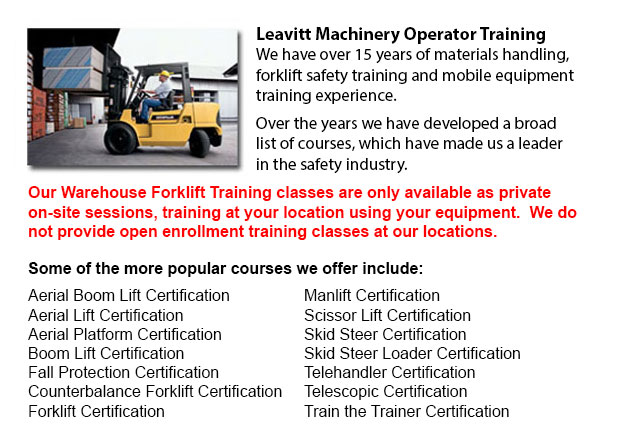
Vernon Warehouse Forklift Training Programs - Warehouses could be industrial, commercial or retail facilities. Their function can vary from product distribution to retailing bulk products. Regardless of the kind of warehouse, employees within warehouse settings must be well trained in safety measures related to material storage and handling, conveyor systems, loading docks, and forklifts and pallet jacks. Good housekeeping is essential to an orderly and safe warehouse setting.
Truck and loading dock systems are normally located at a height from the ground. Products exit and enter warehouses through these systems where staff load and unload supplies from ramps and elevated docks. Particular attention should be paid to safety habits in this stage. To avoid falls, install yellow striping along the edge of ramps and docks. Pay attention to the area all-around delivery trucks that are parked at the loading dock, especially the part between dock and the truck. Be certain that while unloading, truck wheels are chocked.
In order to distribute products within the facility, some warehouses make use of a conveyor system. These systems are designed with moving belts and wheels that can pose a pinch point danger. Keep parts of the body and hair well away from conveyors to prevent injury. Elevated conveyors pose a danger to staff beneath if safety nets are absent. Staff ought to know how to stop conveyors in the event of emergency. Be aware of the location of emergency stop buttons and off switches. When servicing conveyors, lock out/tag out procedures are mandatory.
In order to make it easier to transport materials, pallet jacks and forklifts are most usually used. The lift truck operator would require training and certification. Pallet jack operators do not require certification, but must be trained about the machinery. Training courses instruct operators in the correct ways for lifting objects and moving them to their assigned place. Neither forklifts nor pallet jacks should ever be utilized to lift or transport employees.
To allow for adequate room for equipment and individuals to pass, storage shelving and rack systems help to create an orderly and efficient work space, specially if they are properly braced. Careful and slow placement of good is required to prevent accidents caused by products falling off the facing aisle. Aisles must be kept clear by storing products flat and inside the shelving units. Pallets are utilized for stacking products. They should be in good condition, and palleted products should be baled or shrink-wrapped, whenever possible.
PPE or personal protective equipment must be worn when needed to help protect the employees' heads, limbs, feet and hands. Bump caps or hard hats, gloves and steel-toed shoes are common PPE.
Slippery floors which are pocked with pits and dents may present significant hazards, making good housekeeping really essential. Warehouse docks and floors should be clear of debris oil and dirt. The area must be kept clear of baling materials, garbage and boxes.
-
Vernon Heavy Equipment Training Programs
Vernon Heavy Equipment Training Programs - At whatever given construction site, there are often different types of machinery which are ready to be used. These heavy and light machines need both operators to run them and mechanics to fix them. Trainee... More -
Vernon Forklift Safety Training
Vernon Forklift Safety Training - People wanting work in industries that operate lift trucks should undergo a forklift safety training program before becoming a certified operator of a lift truck. There are a lot of ways to go about acquiring forklif... More -
Vernon Aerial Boom Lift Ticket
Vernon Aerial Boom Lift Ticket - Aerial platform lifts can accommodate various odd jobs involving high and tough reaching places. Normally used to complete regular preservation in structures with tall ceilings, prune tree branches, elevate heavy shel... More -
Vernon Manlift Safety Training
Vernon Manlift Safety Training - Manlift operators need to be cognizant and aware of all the potential dangers which are associated with particular classes of scissor lifts. They need to be able to operate the scissor lift in a way that protects not... More -
Vernon Forklift License
Vernon Forklift License - Obtaining a forklift certification or forklift license in North America will require the one training to carry out hands-on training in addition to classroom instruction. The provincial, federal and state regulatory bodies a... More -
Narrow Aisle Forklift, Order Picker, Electric Pallet Jack, Electric Pallet Truck Certification in Vernon
A pallet lift is a model of equipment dedicated in the transporting of pallets of many dimensions and weights. They can be utilized as an appendage for forklifts, cranes and other styles of heavy machinery or be applied on their own. Pallet hoists ar... More -
Vernon Boom Lift Safety Training
Vernon Boom Lift Safey Training - Boom lifts are a type of elevated work platform or aerial lifting device which are commonly utilized in construction, industry, and warehousing. Boom lifts can be utilized in practically any surroundings because of t... More -
Vernon Manlift Operator Training
Vernon Manlift Operator Training - The aerial lift or manlift is a specialized kind of hydraulic platform that is designed to lift a person vertically giving it an alternate name of a vertical personnel lift. These machinery are widely utilized for a... More

Forklift Certification Vernon
TOLL FREE: 1-888-254-6157
Vernon, British Columbia
forkliftcertificationvernon.com
Email Us
About Us


